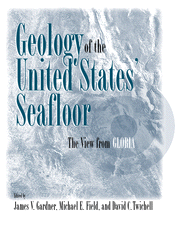Book contents
- Frontmatter
- Contents
- Contributors
- Foreword
- Introduction
- Part I The GLORIA System and Data Processing
- Part II U. S. East Coast EEZ
- Part III Gulf of Mexico and Caribbean EEZ
- Part IV U. S. West Coast EEZ
- Part V Alaskan EEZ
- Introduction
- 15 Sediment Pathways in Gulf of Alaska from Beach to Abyssal Plain
- 16 Sedimentation Along the Fore-Arc Region of the Aleutian Island Arc, Alaska
- 17 Aleutian Basin of the Bering Sea: Styles of Sedimentation and Canyon Development
- 18 Geology of the Kula Paleo-Plate, North Pacific Ocean
- Index
18 - Geology of the Kula Paleo-Plate, North Pacific Ocean
Published online by Cambridge University Press: 25 January 2010
- Frontmatter
- Contents
- Contributors
- Foreword
- Introduction
- Part I The GLORIA System and Data Processing
- Part II U. S. East Coast EEZ
- Part III Gulf of Mexico and Caribbean EEZ
- Part IV U. S. West Coast EEZ
- Part V Alaskan EEZ
- Introduction
- 15 Sediment Pathways in Gulf of Alaska from Beach to Abyssal Plain
- 16 Sedimentation Along the Fore-Arc Region of the Aleutian Island Arc, Alaska
- 17 Aleutian Basin of the Bering Sea: Styles of Sedimentation and Canyon Development
- 18 Geology of the Kula Paleo-Plate, North Pacific Ocean
- Index
Summary
Abstract
The only recognized fragment of the Kula Plate occurs south of the western Aleutian Islands in the North Pacific Ocean. The paleo-plate remnant is now trapped within the Pacific Plate and bounded by Stalemate Ridge on the south and west, by the inner wall of the Aleutian Trench on the north, and by the Kula Rift (central graben of the Kula-Pacific Ridge, an extinct spreading center), on the east. The paleo-plate, presently about 7,600 km2 in area, is sliding past the arc at about 80 km/my and is currently being deformed; subduction is occurring, at least as far west as 169° E longitude. In the region where the Kula Paleo-Plate and the Stalemate Ridge are colliding with the Aleutian Ridge (KUSAR collision zone), the trench floor is raised about 1,400 m and the fore-arc region of the Aleutian Ridge is greatly deformed. The collision left a tectonic indentation (Attu Bight) as the bathymetrically high Stalemate Ridge scraped along the inner trench wall during its westward migration on the Pacific Plate.
The presence of magnetic anomalies 18R to 21N indicates a maximum age range for the Kula Paleo-Plate of about 47.5 to 40.5 Ma. Seafloor spreading rates of the Kula Paleo-Plate were slower than rates on the Pacific Plate during final stages of spreading along the Kula-Pacific Ridge. Cessation of spreading apparently occurred after the plate motion change recorded by the Hawaii-Emperor Bend.
- Type
- Chapter
- Information
- Geology of the United States' SeafloorThe View from GLORIA, pp. 333 - 354Publisher: Cambridge University PressPrint publication year: 1996



